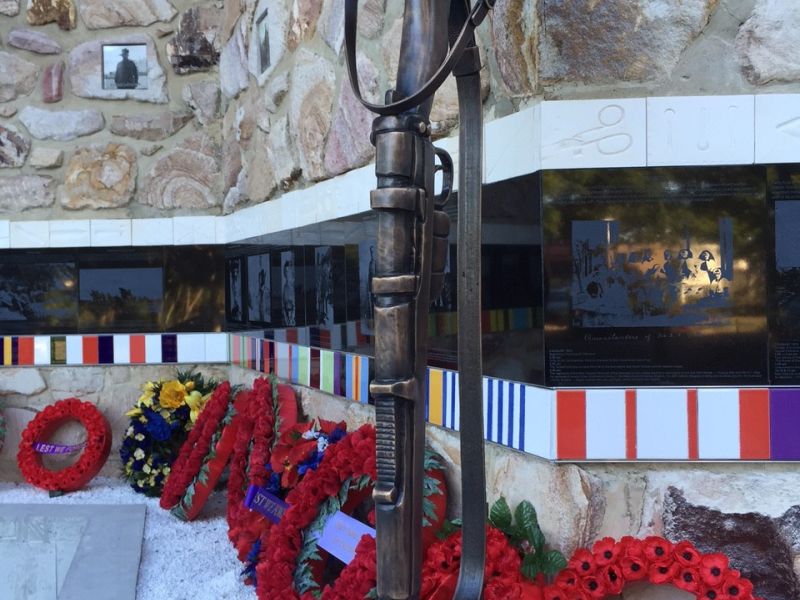Anzac Memorial Wall
The Anzac memorial tells a story of a fictitious boy in 1914 who joins the AIF from the local area, travels for the first time across state and overseas like most did, trains in the desert, deployed to a foreign beach and instantly becomes a soldier, survives the war, returns home, marries his sweetheart, raises a family, becomes a grandfather and great grandfather. His Anzac legacy for peace is narrated visually and commemorated 100 years after his encounter in 1915.
The memorial evokes imagination through the visual conversation between object and memory by impressing these into clay, creating ‘memory fossils’ with icons of hope and of home. For example, the front door key or a wedding ring as perhaps were carried going ‘over the wall’ into battle.
Artefacts from Gallipoli and WW1 are in other cards responding to the timeline in the granite story tiles inspired by black and white film footage imagery. These depict scenes of leaving the Australian shores, desert training in Africa and the landing on Anzac cove, to the battles, daily life, notable Anzacs, indigenous soldiers, and nurses and of home and hope.
The campaign ribbons date from the first battle in 1863 to peacekeeping missions in 2019. They are laid out lineally below the granite story tiles and show the extent of participation in conflicts over the last 150 years.
The shape or form of the memorial uses the existing faceted walling to evoke the Gallipoli cove topography of headlands and bays. The profile of the cliffs and hills or vertical terrain are also stylised from the rising sun AIF badge.
The sloping ends of the walls are the time hands of arrival to departure.
The rusting steel shard with the cruciform of ‘Lest We Forget’ is inspired by the bow of the transport ship aggressively piercing into the waves, as the junction between being on a boat and the Gallipoli landing.
The floor is the Aegean sea moves in blue lines from dark to light represent the deep to the shallow. It flows into bays and headlands of the faceted walls with the bullet tracer yellow lines extending to the edge of the memorial, in a sense warning the visitor.
The red and white ceramic bench for the nurses is inspired by the nurse’s cloak worn at that time. The bench provides rest and reflection and a panoramic view of the memorial.
This extraordinary memorial is an engaging story of Gallipoli through the visual and tactile, creating a narrative like no other in Australia.
The memorial is also different is its recognition not just of the soldiers but also of women, nurses, the home effort and in particular, indigenous soldiers.
It was designed and built by Dr Pete Macfarlane, the celebrated memorial architect and stonemason.
 Geebung Zillmere Bald Hills Aspley RSL
Geebung Zillmere Bald Hills Aspley RSL